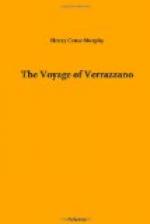This discourse fails, therefore, as an authority in favor of the Verrazzano discovery, or even of the existence of a claim in its behalf; the statement which it contains in relation to Verrazzano, originating with Ramusio adding nothing to the case. [Footnote: The writer gives, however, some details in relation to the Indians and the fisheries along the easterly coast of Newfoundland, illustrative of certain points which have arisen in the course of this enquiry. Continuing his remarks, as given in the text, in regard to the Indians inhabiting the southerly coast between Cape Race and Cape Breton, he states: “There are many stags and deer, and birds like geese and margaux. On the coast there is much good fishery of cod, which fish are taken by the French and Bretons, only because those of the country do not take them. In the coast running north and south, from Cape de Ras to the entrance of the Castles, [straits of Belle-Isle] there are great gulfs and rivers, and numerous islands, many of them large; and this country is thinly inhabited, except the aforesaid coast, and the people are smaller; and there is great fishery of cod as on the other coast. There has not been seen there either village, or town, or castle, except a great enclosure of wood, which was seen in the gulf of the Castles; and the aforesaid people dwell in little cabins and huts, covered with the bark of trees, which they make to live in during the time of the fisheries, which commences in spring and lasts all the summer. Their fishery is of seal, and porpoises which, with certain seafowl called margaux, they take in the islands and dry; and of the grease of said fish they make oil, and when the time of their fishery is ended, winter coming on, they depart with their fish, and go away, in little boats made of the bark of trees, called buil, into other countries, which are perhaps warmer, but we know not where.”]
VIII.
II. The verrazano map. It is not an authoritative exposition of the Verrazzano discovery. Its origin and date in its present form. The letter of Annibal Caro. The map presented to Henry VIII. Voyages of Verrazzano. The globe of Euphrosynus Ulpius.




